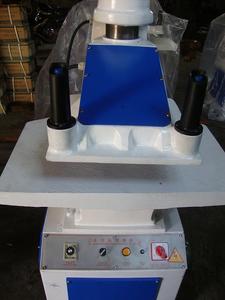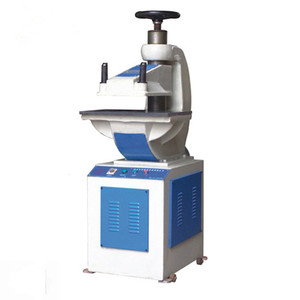Types of punching machines
A punching machine is a machine tool that uses a punch to change the shape of workpieces. Generally, it is used to make holes in the workpieces. There are different kinds of punching machines for sale, each suitable for use in a specific industry or application. Here are some common types of punching machines:
-
Hydraulic punching machine
The hydraulic punching machine uses a hydraulic mechanism to operate. It relies on hydraulic power to drive the punch for cutting or shaping. This type has strong cutting capacity and can deal with heavy-duty or thick materials. It is also commonly used in industrial manufacturing.
-
Manual punching machines
As its name suggests, the manual punching machine requires operators to apply their force to move the handle for punching. This operation may be simple and easy to learn, but it also makes the machine inefficient. Manual punching machines are suitable for small businesses that do not need to process large volumes of workpieces daily.
-
NC punching machines
The numerical control (NC) punching machine is a punch press machine fitted with a numerical control system. It offers more precise control over the punching process and facilitates automation. The NC punching machine provides consistent and accurate results. In addition, it is suitable for high-volume production.
-
Automatic punching machines
An automatic punching machine operates automatically without requiring manual assistance. They can provide high levels of efficiency and production capacity. In addition, they have automation features that ensure consistent and accurate punching operations.
Specifications and maintenance of punching machines
The specifications of the punching machine may vary depending on the type. Here's a brief overview of the general specifications.
- Capacity: The capacity indicates the thickness of the material that the machine can punch. Metal and hydraulic punching machines can usually handle thicker materials than manual machines.
- Die sizes: Die sizes determine the shapes and sizes of holes that the punching machine can create. The die may be interchangeable for different applications in some models.
- Punching speed: This refers to how quickly the punching machine can perform punching operations. It can be measured in units per minute or in calling time for each hole.
- Power: The power is the power output, measured in kilowatts (kW) or horsepower (HP). Higher power provides more punching capacity and speed.
- Control system: Some punching machines have a computer numerical control (CNC) system or other automatic control systems that allow precise control of punching position and speed.
- Dimension and weight: The dimensions and weight are the size and weight of the machine itself. Larger and heavier machines usually require more space and handling.
In addition to the above specifications, some punching machines may have additional features and accessories, such as automatic feeding systems, material clamps, lubrication systems, etc., which can improve the efficiency and accuracy of punching.
Maintenance
Regular maintenance ensures reliability and durability. Here are some maintenance tips for a punching machine:
- Clean: Cleaning the machine frequently helps get rid of dirt, debris, and oil that accumulates during operation. Use a cleaning agent to wipe all surfaces and remove any residue. It is also important to keep the surrounding environment tidy and organized to avoid any foreign objects that may affect the operation of the machine.
- Lubrication: Lubricate the punching machine's moving parts and bearings on the regular basis. Use appropriate lubricant and ensure even spreading. Regular lubrication helps reduce abrasion and wear and maintains the smooth operation of the machine.
- Inspection: Check the punching machine regularly to inspect components for damage or looseness. Check whether the punch die and slot have any deep pits or abrasions. If there are any issues, it's important to quickly repair or replace them to prevent further damage or affect the punching quality.
- Adjustment: Regularly adjust the punching machine to ensure its accuracy and consistency. Check and adjust the alignment of the punching die and material feeding system to make sure that the punching position is correct and the punching is smooth.
- Electrical maintenance: Ensure that the electrical components, such as connectors and switches, of the punching machine are free from moisture and pollution. Regularly check the electrical circuits and insulation to prevent electrical faults and safety hazards.
- Maintain documentation: Keep the maintenance and repair records of the punching machine. It documents the maintenance schedule, repair details, replacement parts, etc. This helps the machine operator and maintenance personnel to have an understanding of the maintenance history for better scheduling and decision-making.
In summary, regular maintenance and care ensures the durability and stable operation of the punching machine. Following the above suggestions can ensure its efficient and lasting use.
Industry scenarios of punching machine
The uses of a punching machine illustrate how vital this device is across different jobs. It makes things easier for workers and helps businesses become more efficient.
- Manufacturing: The punching machine is widely used to produce many items. Workers use the machine to cut shapes out of metal sheets to make strong parts like frames, plates, and brackets. These parts work well for vehicles, machines, and buildings.
- Signage and graphics: Businesses that build signs and displays rely on punching machines to shape materials precisely. These machines cut letters, logos, and other designs from metal sheets or vinyl with speed and precision.
- Leather and garments: In the clothing industry, punching machines cut fabric and leather with precision. Automated models handle large volumes, while manual types are for small batches.
- Plastics and composites: Punching machines are not limited to metal. They can cut plastics and composite materials precisely. In the automotive and construction industries, punching machines make panels, insulation, and other lightweight components from plastic materials.
- Packaging: Punching machines create containers used in packaging. They cut out shapes of cardboard or other materials and make boxes, inserts, and protective packaging.
- Aerospace and defense: Precise punching machines are vital in the aerospace and defense industries. These machines cut complex shapes out of lightweight alloys and composite materials to make aircraft components, satellite parts, and defense systems.
- Medical devices: Some punching machines help make medical devices. They cut metal foils, films, and other materials to produce medical equipment like implants, stents, and surgical instruments.
- Construction: Punching machines make construction easier. They shape metal sheets into parts used for roofs, walls, and other structures. Some have added features to bend or weld, which helps create complete assemblies.
- Electronics: In electronics manufacturing, precision punching machines create complex shapes in thin metal foils. These foils become connectors, shields, heat sinks, and other miniature components used in electronic devices like smartphones, tablets, and laptops.
How to choose the price of punching machine
When buying a punching machine for business, it is best to put surplus value first. A higher-value product may give a better return-on-investment in the long run. This may also enhance the business' reputation.
The machine's market appeal and unique selling point should have the result of the price of the punching machine. Find the price of high-demand machines with standard features and higher-end models with exclusive features. Know the needs of customers and the features of the machines to choose the best-selling ones.
Consider the advantages and disadvantages of all types of machines. Manual machines have low-operating costs. It may be a good buying option with little customer demand for cash. Electronics machines are more expensive. Research repair and maintenance costs over time.
Investigate the supply chain. It may be more cost-effective to buy in bulk and stock up, as wholesale prices are lower. Check the shipping costs and customs duties, as these may add to the final retail price of the product.
When deciding the retail price of the punching machine, check the competition's pricing. Set the price to match the competition, but consider the machine's features. A machine with advanced features may justify a higher price.
Use effective marketing strategies to create more demand for products. Find ways to educate potential customers about the benefits of buying a punching machine, even if they have limited cash. Target schools, small businesses, and startups that need new machines to expand their services and products.
FAQ
Q1: What is the price of a CNC punching machine?
A1: The prices of CNC punching machines can vary depending on specific parameters, such as the model, brand, and additional features or configurations.
Q2: What is the price of a hydraulic punching machine?
A2: The prices of hydraulic punching machines can vary depending on specific parameters, such as the model, brand, and additional features or configurations.
Q3: What is the price of an automated punching machine?
A3: The prices of automated punching machines can vary depending on specific parameters, such as the model, brand, and additional features or configurations.
















































































































































































































































